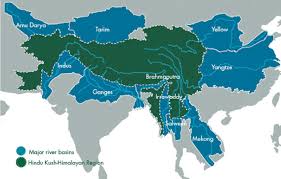Hindu Kush Himalaya:

A recent report by the International Centre for Integrated Mountain Development (ICIMOD) analysed data on snow persistence from 2003 to 2024 and found it to be significantly lower than normal in the Hindu Kush Himalaya (HKH) this year.
- Hindu Kush Himalaya (HKH) region stretches 3,500 kilometres and spans eight countries: Afghanistan, Bangladesh, Bhutan, China, India, Myanmar, Nepal and Pakistan.
- The range has numerous high snow-capped peaks, with the highest point being Tirich Mir or Terichmir at 7,708 meters (25,289 ft) in Chitral, Pakistan.
- It is considered the Third Pole(after the North and South Poles) and has significant implications for climate.
- It contains the largest volume of ice and snow outside of the Arctic and Antarctica.
- The HKH region is the source of ten large Asian river systems: the Amu Darya, Indus, Ganges, Brahmaputra, Irrawaddy, Salween, Mekong, Yangtse, Yellow River, and Tarim.
- The basins of these rivers provide water to 1.9 billion people, a fourth of the world’s population.
- HKH may be divided into three main sections: the eastern Hindu Kush, the central Hindu Kush, and the western Hindu Kush, also known as the Bābā Mountains.
- The inner valleys of the Hindu Kush see little rain and have desert vegetation.




